By Damien Andrews
The Problem
It’s springtime. This year you’ve decided to pour a concrete pad for the new barbecue grill you bought last year, and also for the family picnic table. You’ve decided that the ideal size for the new pad is 10′ x 14′. It’s a pretty ambitious DIY project, but one you know will yield a result that will be enjoyed by the whole family for many years to come.
Comes first light on Saturday morning, and you’re outside with 4 wooden stakes, a 3# sledge hammer and some string. You drive in the first stake at the known corner position. Then you measure 14′ and drive another stake. From there you measure out 10′ and drive another stake. Finally, you measure 14′ again and drive another stake. You then run a string line between all the stakes.
You grab your favorite digging shovel and set about to dig around the outside of the string line. You dig about 6″ outside the string line to allow plenty of space for setting your 2″x4″ forms. Once you dig the outer ring, you’ll remove the dirt inside the ring to allow room for the concrete. But after you get the outer ring dug, the rectangle doesn’t look square to your eye. You double check your measurements between stakes – all is well. But you’re sure the work is not square – so you grab your roofer’s square and take it to a corner stake and check the string line. You were right, even with the relatively small roofer’s square, you can tell the job is not squared.
Hypotenuse To The Rescue
Simply put: the hypotenuse is the longest side of a right triangle (also called a right angled triangle). In case you’ve forgotten your grade school geometry, a right triangle must have a 90° angle – see illustration A. The hypotenuse is opposite that 90° angle. 90° angles are precisely what you want at the corners of your new concrete pad. So, how do we use the hypotenuse to help us get perfect 90° angles at all of our corners… 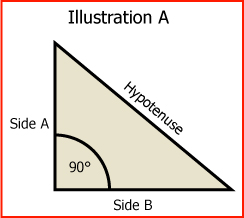
The formula for calculating the hypotenuse is:Hypotenuse the sum of the squares of the lengths of the legs equals the square of the length of the hypotenuse. Referring to illustration B, the formula would be written: a²+b²=c². But this is somewhat misleading – especially to those of us who are geometry challenged. We don’t need to know the length of the hypotenuse squared, we need the hypotenuse. So we take the solution to the above equation (c²) and find its square root ( √ c). Confused yet? Don’t worry – read on and we’ll make all this really simple. 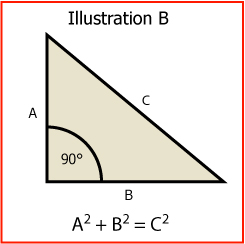
Before we get to the really simple Hypotenuseway to use the hypotenuse to square your work, let’s solve the problem at hand: what is the hypotenuse of your 10’x14′ concrete pad (illustration C). 10² = 100. 14² = 196. Now we know that the hypotenuse squared equals 196′. That doesn’t do us much good at the new pad, so we need to find the square root of 196, which is 17.2′. If we continue down this path, we’ll have to figure out what .2 of a foot is, and then what .4 of an inch is – so that we can accurately measure from one corner of the pad to the other. It’s getting too complicated. 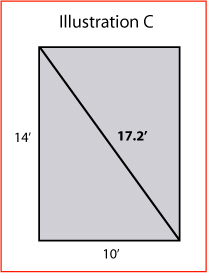
Here’s the easy way to use hypotenuse to square your work. HypotenuseFortunately for us old DIY types, the hypotenuse of a right triangle with one leg that is 3 and the other leg that is 4 is easy. The hypotenuse of the aforementioned is always 5 (illustration D). It doesn’t matter what unit of measurement you use inches, feet, meters, yards, millimeters – anything that works best for the size of job you’re doing. If you’re making a music box, you might want to use inches. Feet will work great on the concrete pad. Yards are the preferred units of measurement for fencing corners.
Now let’s string off our concrete pad again, this time using the hypotenuse to ensure a perfectly square pad…Hypotenuse
(See illustration E) Drive in stake #1. Measure 14′ and drive in stake #2. Run the string line tightly between the two stakes. Make a small mark on the string line 4′ from the second stake. Open a ruler up to about 11′ and place the beginning of the ruler at the bottom of the second stake – get it close to square. Now, using a second ruler, put one end of the ruler on the 4′ mark and adjust both rulers until ruler 1 is at the 5′ mark on ruler 2. Go out to 10′ on that line and drive the third stake. Run a tight string line between #2 and #3. Repeat this process for the 3rd and 4th stakes – only this time open the ruler on the ground to about 15′ before you start measuring. You can then run a string line between Stake #1 and Stake #4 as they should already be squared, but it won’t hurt to double check! 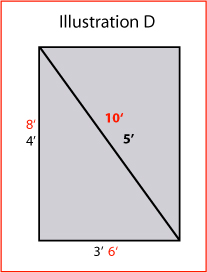
You can also use multiples of this handy formula to satisfy specific job requirements. The hypotenuse of 3×4=5, or 6×8=10, or 12×16=20 – and so forth. Remember, the larger the job, the larger the hypotenuse used for squaring should be to ensure the greatest accuracy. 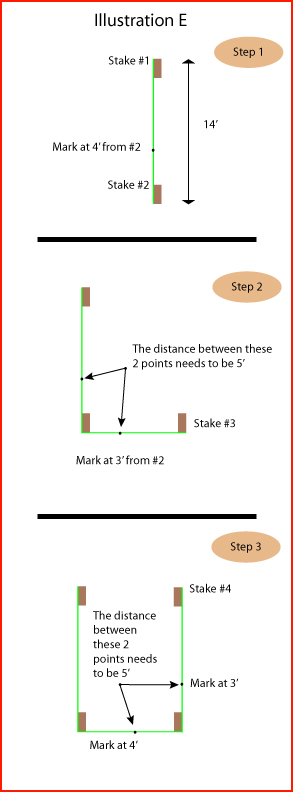
Pro Tips: It’s best to measure hypotenuse with two people. This is to ensure that the string line is not pulled out of line while the measurements are being made. Have one person hold the ruler’s end just below the string line, while the second person measures out the hypotenuse. When you square the 2″x4″ frame lumber, be sure to always measure the hypotenuse from the inside the wood, which is where the concrete will be – not the outside of the wood – and certainly not from the outside of one side to the inside of the other. This will give you an inaccurate hypotenuse.





